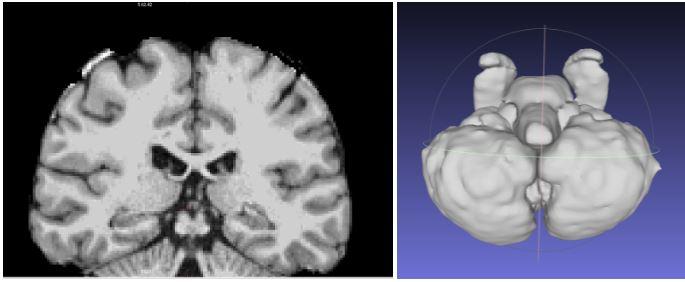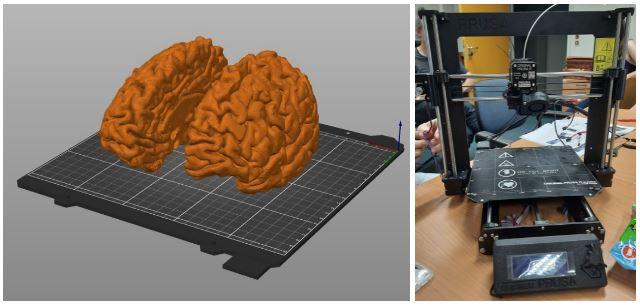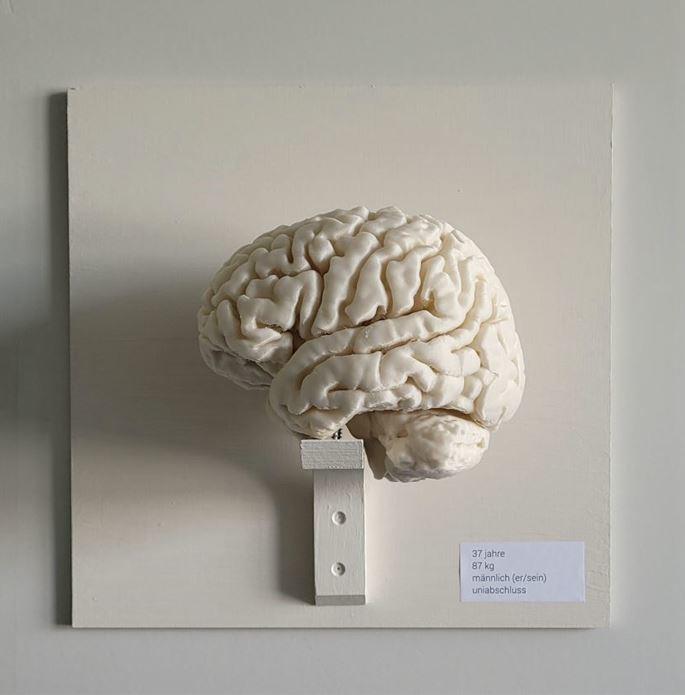Print Your Brain
The Print Your Brain project was started as a X-Student Research Group funded by the Berlin University Alliance (BUA). This innovative teaching format allows young scientists and students of the BUA Excellence Network to work together in a research project (https://www.berlin-university-alliance.de/index.html).
Print Your Brain began at the start of 2021 as a team of students working online to develop an Open Source data processing pipeline by which T1 fMRI scans of students’ brains could be 3D printed.
Within Print Your Brain, several focus groups were formed in order to ensure that each student could best contribute their individual skills, expertise, and passion to the project. In the following we shortly describe each focus group and what role it plays in the Print Your Brain project. The overall structure of the research group implements organization and management similar to small businesses or start-ups to explore how such efficient structures and project management can be applied and adapted to the academic world and to practice teamwork beyond the classical academic environment.
Print Your Brain is an ongoing project that follows all principles of Open Science and has received further funding for the academic winter term 2021.
Print Your Brain: Organization and focus groups
Infrastructure
The Infrastructure team connects the various focus groups within Print Your Brain by overseeing and documenting meetings, maintaining and guiding infrastructure for communication, and acting as central nexus for information exchange among focus groups. Regular operations of this team include:
- Managing central data storage
- Overseeing classical project management combined with SCRUM elements
- Organizing online business communication and meeting platforms
Data Processing

The data processing group is responsible for reconstructing raw structural MRI images into 3D printable mesh files. This focus group has tackled four major tasks:
- Data Preparation: the data is prepared in BIDS file format and quality control of the dataset is performed.
-
Artifact Correction: the surface of the brain is reconstructed from structural MRI using freesurfer and correction of artifacts is performed.
-
Brain Part Parcellation: brain parts are generated and merged of brain parts. The brain part parcellation is responsible for making a 3D base format of the MRI scan and highlighting each hemisphere, part of the brain and merging it into one single file.
-
Trimming the Brain: the parcellated brain is further processed and trimmed in open source 3D processing software (Meshlab).
Going forward, the team plans to create scripts, example data, 3D printable brain files, and guides in order to ensure that future students and other interested parties can easily 3D-print their own brains after acquiring a T1 fMRI scan of their brain. A preliminary guide for installing Freesurfer (software for processing T1 fMRI scans) for various operating systems and for completing a tutorial using the above modules will be available soon.
Open Science
The Open Science focus group publishes code and other informative materials from the Print Your Brain: Data Processing team in accordance with open science guidelines, and manages the Print Your Brain GitHub.
3D Printer

The 3D Printer team has researched, chosen, and assembled the printer. The focus group selected optimal software in order to transform the 3D brain models (created by the Print your Brain: Data Processing team) into a printable format, and optimized the printer settings.
Product Design & Public Relations
The product design & public relations focus group is in charge of product design, strategy, and marketing for the overall project.

Project Members
Dr. rer.nat Timo Torsten Schmidt Project initiator, ideator and leader of the X-Student Research Group
Timo is neuroscientist and works as a lecturer and research associate in the Neuroimaging and Neurocomputation Unit at Freie Universität Berlin. He is interested in the neural basis of human consciousness. He works with methods from the field of computational cognitive neuroscience with a focus on functional neuroimaging.
Anne Jellinghaus 3D Printer, Open Science
Anne is a feminist and does a lot of feminist work in her free time. She loves travelling, reading books about the brain and cooking marmalade.
Annick Langlois Infrastructure, Data Processing
Christoph Hüttl 3D Printer, Data Processing
Christoph enjoys cycling, playing soccer and spending time with his loved ones. He’s interested in learning more about the human body and brain.
Cyrus Iyapanah Infrastructure, 3D Printer
Darshil Shah Data Processing, Open Science
Darshil is a creative thinker, writer and theatre practitioner, interested in neurons and narratives.
Elaine Pinheiro 3D Printer, Open Science
Frederik Lache 3D Printer
Ilana Harris Open Science, Product Design & Public Relations
Ilana enjoys listening to music (esp. hip-hop and punk) and choral singing.
Jordan Elias 3D Printer
Joshua Moritz Witt Data Processing
Jordan enjoys hiking, travelling and music cognition.
JiHoon Kim Infrastructure, Data Processing
JiHoon likes playing badminton, cooking, and eating Tteok-bokki.
Kağan Porsuk Data Processing
Lynn Janyen Data Processing
Lynn enjoys listening to and making music, as well as photography and graphics.
Ida Mayer Open Science, Product Design & Public Relations
Marianna Elisa Schmidt Data Processing
Marianna is interested in neuroimaging data analysis (i.e. surface-based morphometry in fMRI) with a special focus on consciousness research.
Michele Fullilove 3D Printer, Infrastructure
Michele enjoys spending time with family, camping, movies, music, arts/crafts, and world puzzles, interested in neural mechanisms of autism and language/literacy
Monalisa Chikezie Product Design & Public Relations, Data Processing
Sabrine Seidel Data Processing
Sabrina enjoys sewing and studying Japanese in her free time.
Saloni Kothari Data Processing, Open Science
Zoya Mooraj Product Design & Public Relations
Keywords
- Neuroscience, 3D print, brain, Center Cognitive Neuroscience Berlin, Berlin University Alliance, X -student research group, Exzellenzstrategie
